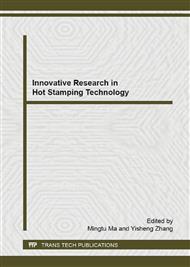[1]
R. Östlund, D. Berglund and M. Oldenburg, Analysis of a hat profile with tailored properties subjected to axial compression, in 4th International Conference on Hot sheet metal forming of high-performance steel , Luleå, (2013).
Google Scholar
[2]
Hallquist, J O, Ls-Dyna Theory manual, Livermore software corporation, (2006).
Google Scholar
[3]
P. Åkerström, G. Bergman och M. Oldenburg, Numerical implementation of a constitutive model for simulation of hot stamping, Modelling and simulation in material science , vol. 15, pp.105-119, (2007).
DOI: 10.1088/0965-0393/15/2/007
Google Scholar
[4]
A. S. Oddy, M. J. M. J och K. L, Microstructural predictions including arbitrary thermal histories, reaustenization and carbon segregation, canadian metallurgical quartly, vol. 3, pp.275-283, (1996).
DOI: 10.1179/cmq.1996.35.3.275
Google Scholar
[5]
J. S. Kirkaldy och D. Venugopalan, Prediction of microstructure and hardenability in low alloy steels, International conference on phase transformations in ferrous alloys, i International conference on phase transformation in ferrous alloys, Philadelphia, USA, (1983).
Google Scholar
[6]
M. V. Li, N. D. V, L. L. Meekisho och D. G. Atteridge, A computational model for the prediction of steel hardenability, Metallurgical and materials transactions, vol. 29B, pp.661-672, (1998).
DOI: 10.1007/s11663-998-0101-3
Google Scholar
[7]
D. P. Koistinen och M. R. E, A general equation prescribing the extent of the austenite-martensite transformation in pure iron-carbon alloys and plain carbon steels, Acta Metallurgica, vol. 7, pp.59-60, (1959).
DOI: 10.1016/0001-6160(59)90170-1
Google Scholar
[8]
D. F. Watt, L. Coon, M. Bibby, J. Goldak och C. Henwood, An algorithm for modeling microstructural development in weld heat-affected zones (Part A) Reaction kinetics, Acta Metallurgical, vol. 11, pp.3029-3035, (1988).
DOI: 10.1016/0001-6160(88)90185-x
Google Scholar
[9]
I. Doghri och A. Quaar, Homogenization of two-phase elasto plastic composite materials and structures Study of tangent operators, cyclic plasticity and numerical algorithms, International Journal of Solids and Structures, vol. 40, pp.1681-1712, (2003).
DOI: 10.1016/s0020-7683(03)00013-1
Google Scholar
[10]
S. Golling, R. Östlund och M. Oldenburg, Implementation of homogenization scheme for hardening, localization and fracture of a steel with tailored material properties, i Hot sheet metal forming of high performace steel, Luleå, Sweden, (2013).
Google Scholar
[11]
H. H, D. Berglund, S. K och M. Oldenburg, Formulation of a finite element model for localisation and crack initiation in components of ultra high strength steels, i 2nd International conference on Hot sheet metal forming of high-performance steel, Luleå, Sweden, (2009).
Google Scholar
[12]
H. Hooputra, G. H, D. H och H. Werner, A comprehensive failure model for crashworthiness simulation of aluminium extrusions, International journal of crashworthiness, vol. 5, pp.449-463, (2004).
DOI: 10.1533/ijcr.2004.0289
Google Scholar
[13]
J. Lemaitre, How to use damage mechanics, Nuclear Engineering and design, vol. 80, pp.233-245, (1984).
DOI: 10.1016/0029-5493(84)90169-9
Google Scholar
[14]
M. José, M. César de Sá och M. Pedro, Damage and fracture in metal forming processes, i COMPLAS VIII, Barcelona, Spain, (2005).
Google Scholar
[15]
G. Bergman och D. Berglund, A finite element model for failure prediction in hot stamped components with tailored material properties, i Hot sheet metal forming of high performance steels, Luleå, Sweden, (2013).
Google Scholar
[16]
S. Storen och J. Rice, Localized necking in thin sheets, Journal of the mechanics and physics of solids, vol. 23, pp.421-441, (1975).
DOI: 10.1016/0022-5096(75)90004-6
Google Scholar
[17]
M. Hori och S. Nemat-Nasser, Micromechanics: Overall Properties of Heterogeneous Materials, Amsterdam: Elsevier Science Publishers, (1999).
Google Scholar


